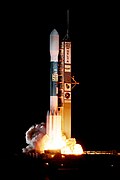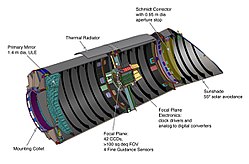Kepler (spacecraft)
Kepler is a space observatory launched by NASA to discover Earth-like planets orbiting other stars.[1] The spacecraft, named in honor of the 17th-century German astronomer Johannes Kepler,[2] was launched on 7 March 2009.[3] It was active for 16 years, 9 months and 14 days as of December 21, 2025.[4]
The Kepler mission is "specifically designed to survey a portion of our region of the Milky Way galaxy to discover dozens of Earth-size planets in or near the habitable zone and determine how many of the billions of stars in our galaxy have such planets".[5] It works by the occultation method. A photometer continually monitors the brightness of over 145,000 main sequence stars in a fixed field of view.[6] This data is transmitted to Earth, then analyzed. The aim is to find periodic dimming caused by extrasolar planets which cross in front of their host star. As of January 2013, there are a total of 2,740 candidates.[7][8][9]
Kepler is part of NASA's Discovery Program of relatively low-cost primary science missions. The telescope's construction and initial operation were managed by NASA's Jet Propulsion Laboratory. To start with, the mission lifetime was 3.5 years. In 2012, this was extended to 2016,[8][10] partly due to difficulties in processing and analyzing the huge volume of data collected by the spacecraft.[11]
Kepler retires
The Kepler space telescope has had to give up its planet-hunting mission because its pointing system has problems which the engineers cannot fix.[12]
Kepler (spacecraft) Media
Kepler's image sensor array. The array is curved to account for Petzval field curvature.
References
- ↑ Koch, David; Gould, Alan (2009). "Kepler Mission". NASA. Archived from the original on 2014-03-06. Retrieved 2009-03-14.
- ↑ DeVore, Edna (2008). Closing in on Extrasolar Earths. http://www.space.com/searchforlife/080619-seti-extrasolar-earths.html. Retrieved 2009-03-14.
- ↑ NASA Staff. "Kepler Launch". NASA. Retrieved 2009-09-18.
- ↑ Time since launch.
- ↑ NASA Staff. "Kepler Mission/QuickGuide". NASA. Archived from the original on 2012-05-08. Retrieved 2011-04-20.
- ↑ AAS Staff. "Meeting Program and block schedule". American Astronomical Society. Retrieved 2011-04-20. – click the itinerary builder to get to the abstract of "Kepler planet detection mission: Introduction and first results".
- ↑ "NASA approves Kepler mission extension". kepler.nasa.gov. 2012. Archived from the original on 2013-05-13. Retrieved 2013-01-08.
- ↑ 8.0 8.1 "NASA extends planet-hunting Kepler mission through 2016". Space.com. 2012. Retrieved 2012-05-02.
- ↑ Administrator, NASA Content (17 April 2015). "NASA's Kepler Mission Discovers 461 New Planet Candidates". NASA. Archived from the original on 1 March 2013. Retrieved 8 January 2013.
- ↑ BBC Staff (2009). "Nasa launches Earth hunter probe". BBC News. http://news.bbc.co.uk/2/hi/science/nature/7926277.stm. Retrieved 2009-03-14.
- ↑ Stephen Clark (2012). Kepler's exoplanet survey jeopardized by two issues. Spaceflight Now. http://spaceflightnow.com/news/n1210/16kepler/. Retrieved 17 October 2012.
- ↑ Kepler: Nasa retires prolific telescope from planet-hunting duties. BBC News Science & Environment, 2013. [1]









